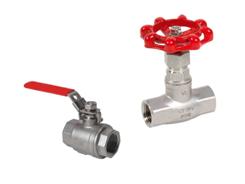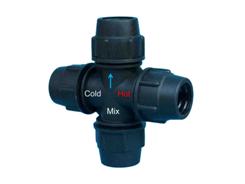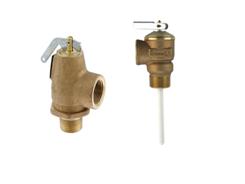A variety of valves are used in solar thermal installations, each type serving an individual purpose. It's important to choose the right valve for the right job.
 Ball and gate valves
Ball and gate valves
Both ball and gate valves control the flow of liquid in pipes, but gate valves should never be used in solar thermal systems because they create resistance when they are closed. You can recognize a traditional gate valve by the external spin handle that lifts or lowers a gate inside the pipe.
Ball valves have a lever on the outside of the pipe and a ball inside. The ball has a hole drilled through the middle. Ball valves offer some flow control: by turning the external lever, the ball is slowly rotated so the hole is perpendicular to the pipe walls, shutting off more and more of the flow. It's not very precise, but it's workable.
It is very important to always choose "full port" or "full flow" ball valves: these have a ball that is bigger than the pipe, through which a hole of the pipe's internal diameter is drilled – when they are in the full "on" position, there is no impediment to the flow in the system. Never use reduced port valves.
These are special valves used on collector arrays. They protect against freezing, by opening when the temperature drops below 44°F (6.6°C) and allowing fresh, warm water to flow through the array. Dole valves are often installed on ICS systems purely as a precautionary measure.
They only work on flooded systems, so they aren't often used outside of precautionary purposes: only ICS systems are flooded and if you live somewhere that freezes occur, you should always install a pressurized system!
 Mixing valves
Mixing valves
Thermostatic mixing valves (TMVs) are essential because solar thermal systems can heat water to surprisingly high temperatures and risk scalding your family. Make the investment in a good, reliable model of valve.
TMVs work by taking in water at two ports – hot and cold – and sending the mix out through a third. They have a handle to set the desired temperature. When the temperature is below the set maximum, water passes straight through; if it rises above the maximum temperature, cold water is added to cool it.
Tempering valves are used in conjunction with TMVs but they are not the same thing. A tempering valve is controlled mechanically and mixes hot and cold water at a given volume, not a given temperature, which means that using one instead of a TMV will result in a water supply that varies in temperature. A TMV ensures a relatively constant heat level, but a tempering valve can lower the temperature in the hot water tank if it gets dangerously high.
It is very important to make sure no heat bleeds back to the cold water supply by installing a check valve on the line going into the tempering valve.
 Relief valves
Relief valves
These valves protect the system from excessive pressure. They have a gasket attached to one end of a plunger and are held closed